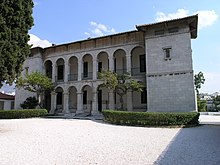Byzantine and Christian Museum
The Byzantine and Christian Museum ( Greek Βυζαντινό και Χριστιανικό Μουσείο , Vyzantino kai Christianiko Mousio), short Byzantine Museum, is a museum in Athens specializing in sacred Christian art.
history
The museum was founded in 1914 and has been located in the Villa Ilissia since 1930, the residence of the French philhellenist Sophie de Marbois-Lebrun , Duchesse de Plaisance (1785-1854), built in 1840 according to designs by Stamatios Kleanthis . Since 1989 training courses and educational programs on early Christian history have also been carried out. In 1993, an extension with a floor area of 12,600 m² was opened, which has since been used to present a large part of the approximately 25,000 exhibits from the 3rd century BC. Allowed until 20th century AD.
Exhibits
The exhibition is chronological and ranges from late Roman art to the souvenirs of Christian refugees from Asia Minor in 1922. A special feature is the treasure of Lesbos , which was buried by the inhabitants of the island to protect against pirates in the 7th century.
Web links
- Official website of the museum , English / Greek
- Page about the museum in Greek-kultur.eu, brief information, German
Individual evidence
- ↑ Source: Website, accessed November 13, 2010.
Coordinates: 37 ° 58 ′ 29 ″ N , 23 ° 44 ′ 40 ″ E

